FEDERAL EQUIPAGE SHOW AND TELL
![]() 12/23/06
12/23/06
The equipment on this page was used mostly by the Army of the Potomac. Western Army equipment can be slightly different.
LINKS:
| PORTSMOUTH RIFLE HOME PAGE | |
| Bayonets and Scabbards |
BRACE YOURSELF
Here are a set of suspenders worn by an Ohio soldier. Aside from being a scarce article of period clothing these have the distinction of having been shot! The entrance and exit points are marked. These were displayed at the 2004 Gettysburg show by John Henry Kurtz.
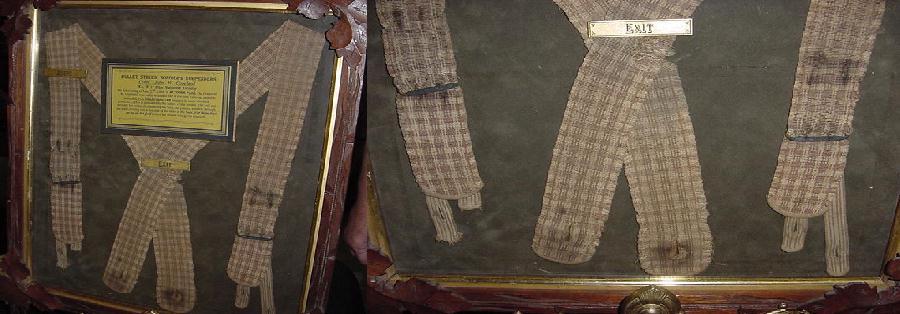
LEATHER BELT KEEPERS AND PUPPY PAW BUCKLES

This original belt belonged to Cpl. Oliver Godfrey of the 14th New Hampshire Infantry. The belt measures 39.5 inches long, 1.75 inches wide and has 5 mechanically punched holes. There were various sizes of buckles used with this model belt and some would not pass through the leather keeper. This buckle appears original to the belt and will not pass through the loop. The problem must have been ignored and the belt was fastned over the keeper. The left view shows the size problem. For those who have Paul Johnson's book on cartridge boxes, look on page 94. The young soldier in the photo is wearing his belt with the keeper behind the belt.
If your repro leather keeper will not allow the buckle to fit through. You have three choices. 1.) Cut off the keeper. Original belts of this style are often found with the leather keeper cut off or un-stitched and removed. 2) Get a smaller buckle. 3) Wear it with the keeper under the belt as shown below and in Johnsons book.
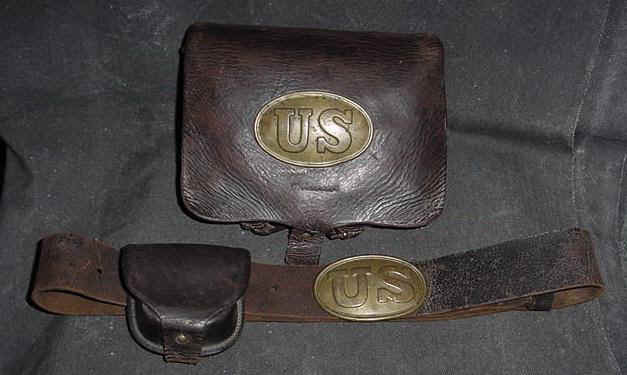
Godfrey's cartridge box, cap box and belt. This box was worn on the belt as evidenced by wear and stretching on the boxes waist belt loops. It contained four complete cartridges when I obtained it. This set also came with a Springfield bayonet in a two rivet, US made scabbard which was made to hold the Austrian Lorenz type bayonet. This bayonet and scabbard can be viewed on my scabbard page.

Late war buff leather waist belt with brass keeper. This was a Bannerman's purchase in the 1950s. If the ears of the keeper are open enough, the belt can be squeezed and slides under the ears as shown.

Three Union brass keepers dug from Confederate works in Petersburg. All have remains of the belt still attached so it is logical to assume they were worn in the as found configuration shown here. It appears only the center keeper is open enough to function as intended (see view on right). I believe many soldiers with this style keeper simply bent the keeper closed, fastned the waist belt and ignored the keeper.
MORE ACCOUTERMENTS
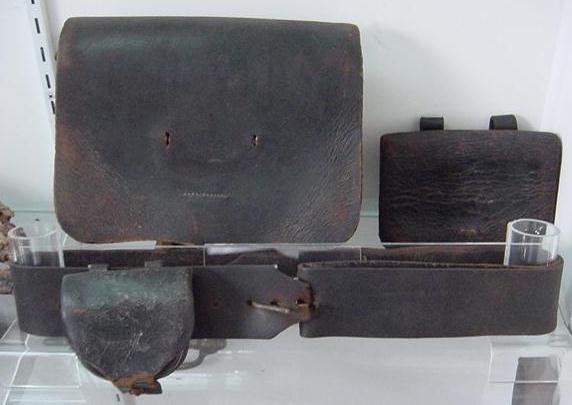 ACCOUTERMENTS I.D. TO SELDON SIKES,
211th PA. INF.
ACCOUTERMENTS I.D. TO SELDON SIKES,
211th PA. INF.
This is one of the most individualized set of accouterments I have come across. The waist belt is made from the cartridge box shoulder strap with a knapsack hook for a buckle. The pistol cartridge box came with the set. The cartridge box is for the .69 ammunition. The haversack (not shown) was also included and it is a half of McCellan saddle bag which was worn on the belt with a shoulder strap of leather.
I believe Seldon actually wore these items in this fashion. On his official records he is charged with losing a belt plate. At the time I acquired this set his .69 Cal Musket was also for sale from the same dealer. The 211 PA was a late war unit which evidently was issued the old smooth bore muskets. The regiment served on the Howlett Line and also took part in the re-capture of Ft. Steadman in Petersburg.
Shown below is Seldon's haversack (?) which is made from half of a saddle bag. It was worn on the belt with the leather strip used as a shoulder strap.
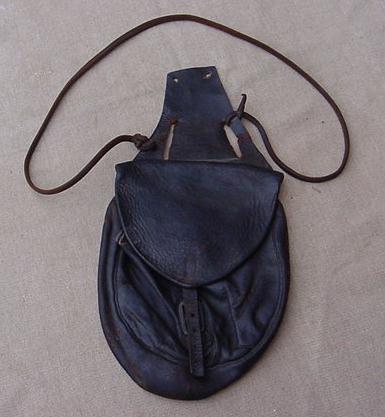
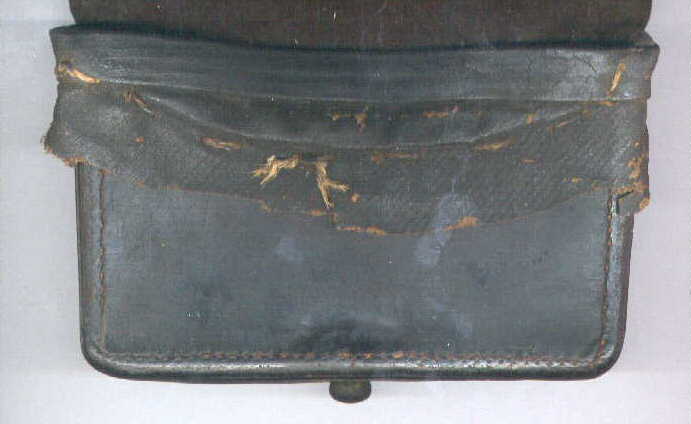
GUM FABRIC This is the pistol cartridge box shown in the above group belonging to Seldon Sikes. The front top of the leather has been cut away and a piece of gum blanket sewn in as a repair or whatever. The seam along the top appears to be original to the blanket. It feels smooth and appears to be rubber that has become dry. The coating on the rest of the fabric is much thinner and only applied to one side. I can't imagine why the Pvt. Sikes made this modification. Perhaps he was bored or just liked wearing personalized accrouterments. Thought it would be interesting as there are not many pieces of gum blanket still around to look at.
STITCH COUNTERS DELIGHT
IMO one of the most important physical feature to look for in a cartridge or cap box are proper positioning of the "ears" located on the under side at each end of the bend in the flap. If these ears do not come down and seal the top of the box when the flap is closed, caps will fall out of cap boxes and moisture will gain entry into the cartridge box. I have seen poorly constructed boxes where these ears will fold up and ride on top of the sides of the box instead of fitting down along the sides. If the ears are positioned and work correctly, whoever made the box knew what they were doing. Shown here are several repro boxes to compare with originals. Before any conclusions are drawn let me say that I picked these two vendors boxes because I own them and use them. After looking at the pictures I think most will agree that both will pass muster.
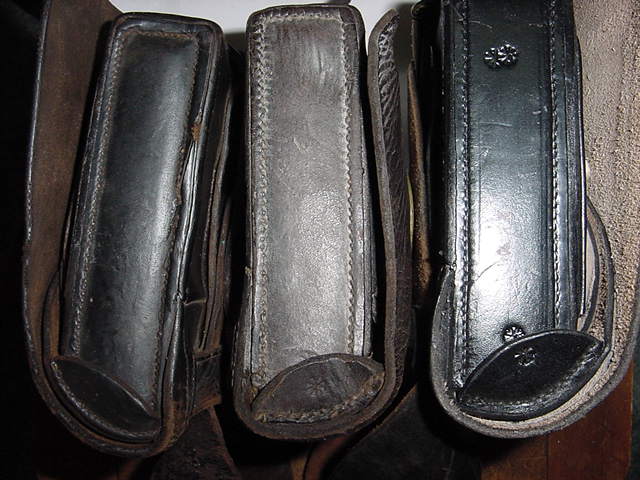 Left are side views of two original, unmarked Pattern 1857
boxes and a Butch Myers P-1857 box. Butch's box is on the right of the picture. Notice in
the picture that there are differences in both original boxes. You can look at several
original boxes and all will have minor differences. After all, they were made by
hand and by different vendors. Notice the correct positioning of the ears at the bottom of the picture.
Left are side views of two original, unmarked Pattern 1857
boxes and a Butch Myers P-1857 box. Butch's box is on the right of the picture. Notice in
the picture that there are differences in both original boxes. You can look at several
original boxes and all will have minor differences. After all, they were made by
hand and by different vendors. Notice the correct positioning of the ears at the bottom of the picture.
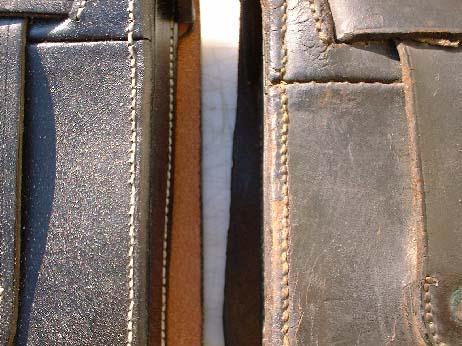
Shown to the right are back views of an original P-1857 Pittman marked box on the right and a Jarnagin P-1857 box on the left. This picture courtsey of Matt Nelson.
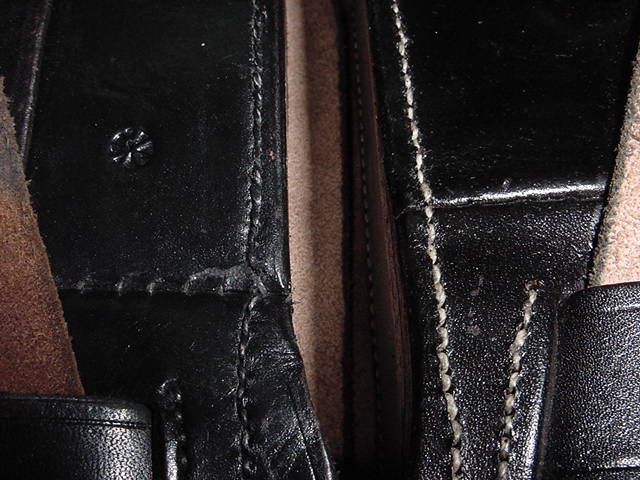
Shown left are back views of a Butch box (left) and Jarnagin P-1839 box (right).
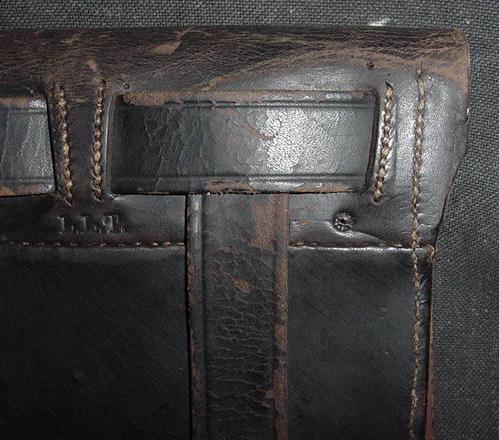
Shown above is the back of an original P-1864 (with embossed US) cartridge box. This box came from Bannermans in the early 1950s and was never issued. It is sewn with white thread as is the cap box below, also from Bannermans.
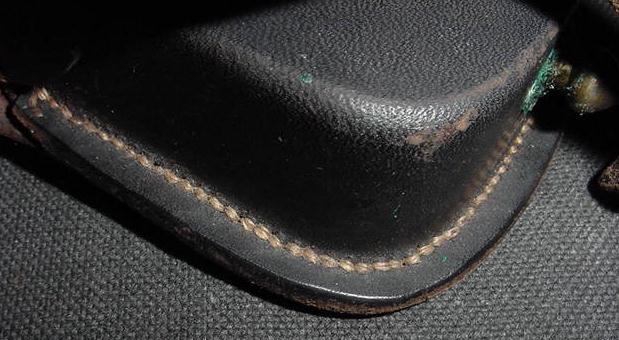
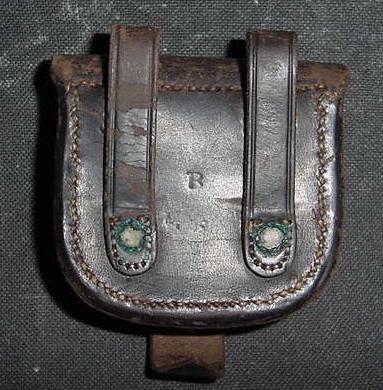
CORPS BADGES
Corps Badges are a really nice touch to an impression. There are two usual places to wear a corps badge, on the head gear and on the blouse. Shown below are some examples of badges and examples of how they were worn.
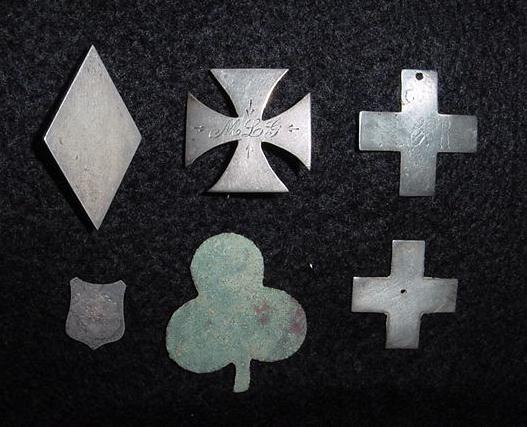 The top row of badges from left to right are
3rd corps, 5th corps and 6th corps. The bottom row shows a 9th corps badge soldier made
from a half dime, brass 2nd corps badge and another 6th corps badge. For a size reference
the 5th corps badge is the size of a quarter. All are silver except for the 2nd corps
badge. The 2nd, 3rd, 5th and 6th corps badges have or appear to have had a T-bar attachment pin
on the back. This would have enabled the badge to be worn on the blouse or head gear very
easily. Many dug badges are found missing this attachment device. The small 9th corps badge
never had any attaching device and was probably made to pass the time while in camp.
Notice the holes in the two 6th corps badges. These badges have lost their attachment pins
and have been soldier modified to be sewn on wherever. Cloth badges were usually worn on the cap. Metal badges could be worn in a variety of places. This sixth corps badge is probably secured in place with the attaching pin.
The top row of badges from left to right are
3rd corps, 5th corps and 6th corps. The bottom row shows a 9th corps badge soldier made
from a half dime, brass 2nd corps badge and another 6th corps badge. For a size reference
the 5th corps badge is the size of a quarter. All are silver except for the 2nd corps
badge. The 2nd, 3rd, 5th and 6th corps badges have or appear to have had a T-bar attachment pin
on the back. This would have enabled the badge to be worn on the blouse or head gear very
easily. Many dug badges are found missing this attachment device. The small 9th corps badge
never had any attaching device and was probably made to pass the time while in camp.
Notice the holes in the two 6th corps badges. These badges have lost their attachment pins
and have been soldier modified to be sewn on wherever. Cloth badges were usually worn on the cap. Metal badges could be worn in a variety of places. This sixth corps badge is probably secured in place with the attaching pin.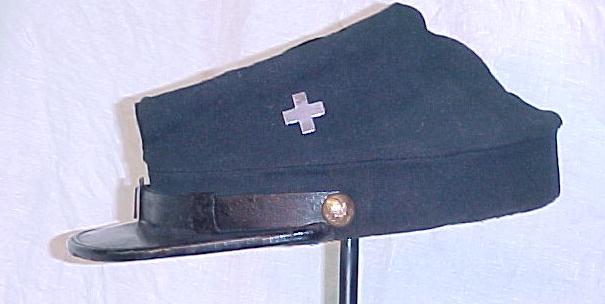
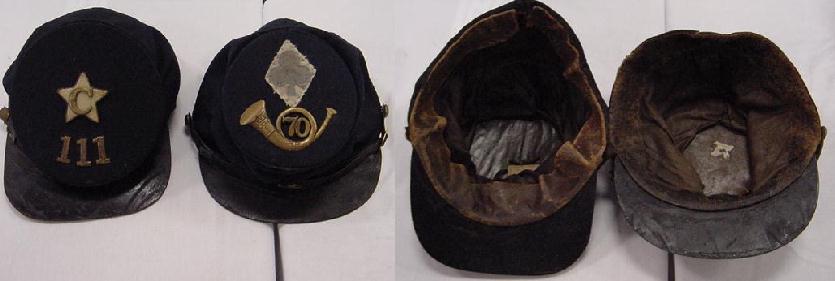
Here are two more Union caps showing the placement of hat brass and corps badges.
Shown below are two more Union caps which visited the Richmond show this Nov. 03.
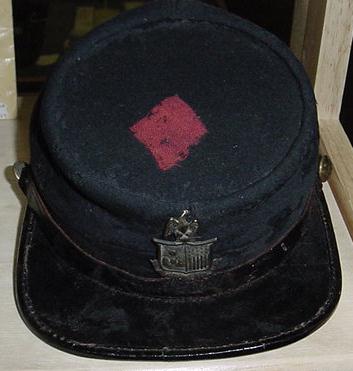
New York Officers kepi with New York badge and 3rd corps, 1st Division cloth badge. Chin strap buttons are staff.
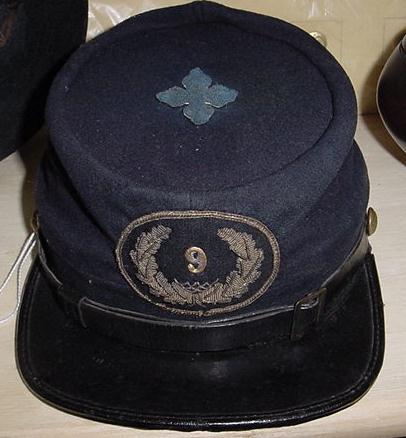
This is reportably a Sgt. kepi with a 10th Corps, 3rd Division cloth badge on the top. It has eagle buttons for the chin strap.
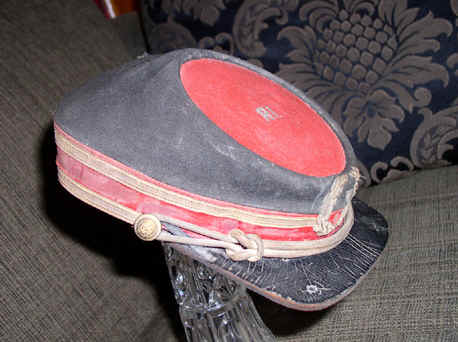 While not sporting a corps badge this 3rd RI
artillery officers kepi is still a nice identified cap and deserves an appearence. It is
marked on the inside, "Sergeant Thomas B. Davis, B Co, 3d Rhode Island Heavy
Artillery". A search of him on Civilwardata.com, revealed that he served the entire
war in that unit. The 3rd RI was in support of the 54th Mass at Ft Wagner, and was at the
battle of Olustee, among other places. This cap is compliments of Doby Pilgrim
While not sporting a corps badge this 3rd RI
artillery officers kepi is still a nice identified cap and deserves an appearence. It is
marked on the inside, "Sergeant Thomas B. Davis, B Co, 3d Rhode Island Heavy
Artillery". A search of him on Civilwardata.com, revealed that he served the entire
war in that unit. The 3rd RI was in support of the 54th Mass at Ft Wagner, and was at the
battle of Olustee, among other places. This cap is compliments of Doby Pilgrim
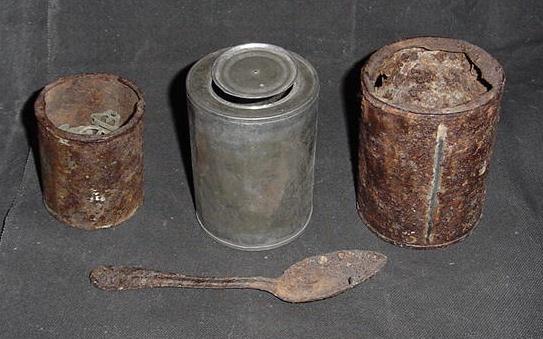 ANYBODY HUNGRY? Shown here
are three Civil War Ration Cans. The center can is unused. The can was filled and
then sealed by soldering the round disc to the top of the can. The can was then heated to
kill the bacteria and the vent hole in the center of the disc was sealed by a drop of
solder. The larger of the dug cans was removed from a Union trench at 2nd Cold
Harbor. The soldered side seam of the can is plainly visible. The spoon was found a very
short distance from the can. The smaller can probably contained milk. Several of these
were found together and some only had two small holes in the top to let the contents out.
The small can came from a late war 5th corps camp. When this camp was discovered trash
piles of ration cans were plentiful laying on the top of the ground. Both of the dug cans appear to
have been opened with a knife.
ANYBODY HUNGRY? Shown here
are three Civil War Ration Cans. The center can is unused. The can was filled and
then sealed by soldering the round disc to the top of the can. The can was then heated to
kill the bacteria and the vent hole in the center of the disc was sealed by a drop of
solder. The larger of the dug cans was removed from a Union trench at 2nd Cold
Harbor. The soldered side seam of the can is plainly visible. The spoon was found a very
short distance from the can. The smaller can probably contained milk. Several of these
were found together and some only had two small holes in the top to let the contents out.
The small can came from a late war 5th corps camp. When this camp was discovered trash
piles of ration cans were plentiful laying on the top of the ground. Both of the dug cans appear to
have been opened with a knife.
COOKING YOUR FOOD ?
Lucky was the soldier who had a small fry pan or a mess mate with one so that raw ration meat could be cooked when on the march. The label on this pan reads "Carried through the Civil War 1861-65 in General Grants Army of the Potomac, by James Warren Williams, 126th Reg't Company C, O.V.I. Enlisted at Columbus, OH at 19 years old, Discharged 1865." Compliments of John Fable.
SLING HOOKS: Recently a reproduction (probably reenactor used) rifle sling was auctioned off on e-bay as an original for over $200.00. The sling was marked Watervliet arsenal but the general appearence of the leather and the sling hook indicated that it was a reproduction. Poor hooks are usually a dead givaway that a sling is a reproduction. All hooks that I have seen on reproduction slings are a brass rod bent over and MAYBE rounded off or pointed at the end. Pretty crude. Below are a few excavated sling hooks. Some are rifle slings and some are sword belt or other type. All are well made and shaped. The hook on the far left is the only one that remotely resembles what is found on reproduction leather slings.

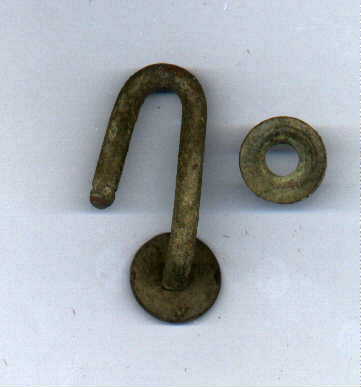 PONCHO GROMMET:
What size is correct for rubber blanket grommets? Well here is a dug one with a
knapsack hook for size comparison. I have gotten into areas and dug large numbers of
these grommets along with miscellaneous Yankee stuff. Very seldom dig any of these
grommets in a Confederate camp unless it is in close proximately to the Union forces (such
as in Petersburg). I have never seen a correct size grommet on a reproduction rubber
blanket either. Jarnagin's is the closest to what I have here.
PONCHO GROMMET:
What size is correct for rubber blanket grommets? Well here is a dug one with a
knapsack hook for size comparison. I have gotten into areas and dug large numbers of
these grommets along with miscellaneous Yankee stuff. Very seldom dig any of these
grommets in a Confederate camp unless it is in close proximately to the Union forces (such
as in Petersburg). I have never seen a correct size grommet on a reproduction rubber
blanket either. Jarnagin's is the closest to what I have here.
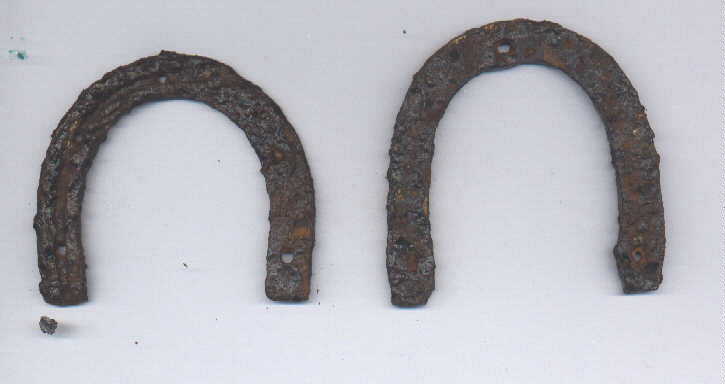
HEEL PLATES: These heel plates are typical of those found in areas visited by the Union armies in Virginia. These were found in a 2nd Corps trench at Cold Harbor. They are the most common style but other varients do exist. Each heel plate shown here was held on by three nails. Heel plates are not recovered in any quantity from Confederate positions. A study of photographs showing dead Confederates at Antietam, Gettysburg and Petersburg do not show a single heel plate however several hob nailed shoes are evident in the Gettysburg photos.
 UNION OFFICERS
BUTTONS: The button on the far left of the picture is an Officers
General Staff button and the remainder are commonly called Eagle I buttons, the I standing
for Infantry. The staff button came in coat size and cuff size with exact size and
features sometimes varying between manufactures. The button was worn by officers serving
in staff positions.
UNION OFFICERS
BUTTONS: The button on the far left of the picture is an Officers
General Staff button and the remainder are commonly called Eagle I buttons, the I standing
for Infantry. The staff button came in coat size and cuff size with exact size and
features sometimes varying between manufactures. The button was worn by officers serving
in staff positions.
During the Civil War the Eagle I buttons shown to the right of the staff button were worn by line officers on coats and vests. They came in several sizes from large size for the great coat to small sizes for wearing on vests, kepis and cuffs. Due to the large number of small eagle I buttons found, I believe they were also worn on privately purchased vests. The large eagle I button shown beside the staff button is the largest size for use on Frock coats. The majority of Frock coat buttons are slightly smaller. The two small eagle I buttons on the right are the size used for vests and cuffs. As with the General Staff buttons, size and features will sometimes vary slightly between manufactures. The only way to positively date an original button of these types as being used in the Civil War is to look at the backmark and check it against a reference book. They were used until the early 1900s when they were replaced by the great seal buttons.
The staff button shown here was dug from the top of a Confederate trench near Five Forks, before it was NPS of course. The eagle I buttons came from a 5th Corps camp in Petersburg.
 ORIGINAL
YANKEE .58 CAL CARTRIDGES: Shown are two minies still in the paper
wrap. They were in a cartridge box owned by Oliver Godfrey of the 14th New
Hampshire. It is interesting to note that the bullet and the powder are wrapped seperately. This can be seen in
the cartridge which has broken open. The powder is wrapped very well and the bullet
is placed on top of the wrapped powder charge. The entire cartridge is then covered
by thin paper. These paper cartridges are very fragile. The purpose of the cartridge box tins was to prevent the cartridges from breaking. Due to the good condition of the paper wrapping, I suspect these cartridges have been in the box since Cpl. Godfrey brought it home.
ORIGINAL
YANKEE .58 CAL CARTRIDGES: Shown are two minies still in the paper
wrap. They were in a cartridge box owned by Oliver Godfrey of the 14th New
Hampshire. It is interesting to note that the bullet and the powder are wrapped seperately. This can be seen in
the cartridge which has broken open. The powder is wrapped very well and the bullet
is placed on top of the wrapped powder charge. The entire cartridge is then covered
by thin paper. These paper cartridges are very fragile. The purpose of the cartridge box tins was to prevent the cartridges from breaking. Due to the good condition of the paper wrapping, I suspect these cartridges have been in the box since Cpl. Godfrey brought it home.
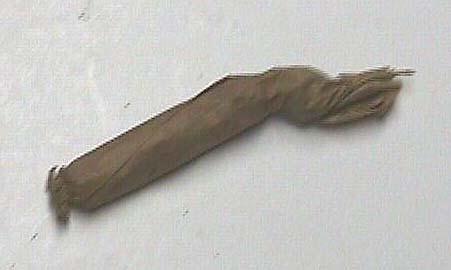
Package of 12 caps which were included with a pack of 10 rounds.
![]()
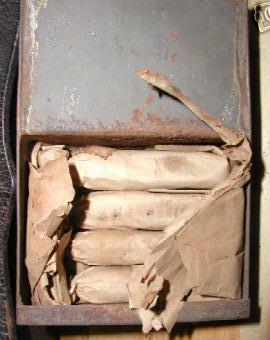
Torn package of original .58 cal. Minies in a cartridge box tin. The precussion caps are located on the left of the cartridge pack.
You are visitor number:
| REENACTORS SHOW AND TELL HOME | Confederate Equippage | PORTSMOUTH RIFLE HOME PAGE |
| Bayonets and Scabbards | Confederate Canteens | Federal Canteens |
This page compliments of the Portsmouth Rifles, Co. G, 9th Va. Inf